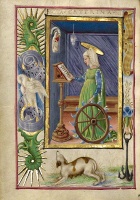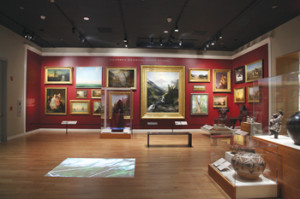
Saint Jerome Extracting a Thorn from a Lion’s Paw, cutting from Master of the Murano Gradual, northern Italy, about 1425-50
Calm St. Jerome extracting a thorn from the paw of a lion; the miraculous intervention that delayed St. Catherine of Alexandria’s execution by the torturous wheel; the gratefulness of everyday life as witnessed by St. Hedwig — these are just a few of the stories that make up the current exhibition “Miracles and Martyrs: Saints in the Middle Ages” at the J. Paul Getty Museum.
Now on display through March 2, 2014, the exhibition features artwork that adorns pages of private prayer books, devotional tracts and even biographies.These images help us better understand how people in medieval times viewed the world around them — and how their connection with saints helped lay the foundation of their faith, says Elizabeth Morrison, senior curator of manuscripts at the Getty who along with Melanie Sympson, staged this exhibition.
When visiting the exhibition, Morrison says, try not to see the saint stories not so much as “historical recounts of actual events,” but rather as lessons on how to live and appreciate life. “They were role models,” she says about the holy men and women who presented images of goodness, piety, sacrifice and even a willingness to suffer torture and death. “These personal stories were meant to resonate with your own life.”
Through the years, devotions and attention to certain saints have waxed and waned. Interest in some saints can be cultural and societal, says Morrison, who points to the example of St. Appolonia who was martyred by having her teeth extracted, and was a very popular devotion for people with teeth problems.
The mediaeval faithful “would ask her intercession because, well, she of all people would understand the pain,” Morrison explains. But with the rise of dentistry, the devotion to St. Appolonia declined.
Still, there are those saints whose stories span centuries. In the exhibit, the rich image of composed St. Jerome tending to the wild lion reinforces the ideal that saints had special connections with not only the spiritual but also the temporal world.
That peaceful composure is also found with St. Catherine of Alexandria who confounded the pagan philosophers of the day with her teachings of Christianity but was still sentenced to death via the “wheel” only to have that miraculously destroyed. But that didn’t save Catherine’s life. She was eventually beheaded, a quicker death than the painful torture of the tortuous wheel instrument.
Morrison points out all the symbolism that is associated with this image: Catherine keeps her finger in place in a book signifying her great intelligence, the dog at the bottom is a sign of loyalty, the anchor and lilies in the right border may be emblems of her family, other border images of a seahorse and pelican are enduring religious symbols. These short images — Twitter for the Middle Ages? — were included so the viewer could take in the whole meaning with just a glance, explains Morrison.
In addition to the horrific images of martyrdom on display (including St. Sebastian whose death by numerous arrows has captured the attention throughout centuries of retelling), the exhibition features saints celebrating the simple joys of everyday life. Morrison presents a large biography of St. Hedwig which was commissioned by her descendants years after she was canonized.
After a life as a mother, wife and noblewoman, St. Hedwig — along with her husband — decided to join in a communal life with fellow religious leading a chaste life doing good deeds. “She was a very down-to-earth woman whom you could easily relate to,” she says of St. Hedwig’s small acts of daily devotion.
On the page are images of Hedwig honoring the life in the convent but showing her thanks to the stairs, the choir loft and even the hand towels. “Her humility is what we see as a model of devotion,” says Morrison adding that her image was particularly inspirational since many other female saints were either virgins or martyrs. “She was a role model to mediaeval women leading regular lives to perform small acts of devotion every day.”
“Miracles and Martyrs: Saints in the Middle Ages” will feature new images rotating at various times through the exhibition. Upcoming events related to the exhibition include:
—A panel on “Why Do We Need Saints?” (Oct. 30, 7 p.m.), presented by Zocalo Public Square, discussing saint devotion, how popular and regional movements have created saints, and what saints have offered to those who love them.
—Gallery talks led by curator Elizabeth Morrison (Nov. 19, Jan. 14 and Feb. 11, 2:30 p.m.).
“Miracles and Martyrs” runs concurrently with “Canterbury and St. Albans: Treasures from Church and Cloister,” on view through Feb. 2, 2014 at the Getty Center. This exhibition showcases 12th-century stained glass from Canterbury Cathedral, plus an extraordinary manuscript made in the same period at St. Albans Abbey that features a section focused on the holy individuals associated with each of these two English institutions: St. Thomas Becket of Canterbury and Christina of Markyate at St. Albans.
“Miracles and Martyrs: Saints in the Middle Ages” will be featured through March 2, 2014 at the Getty Center, 1200 Getty Center Dr., Brentwood. Information: (310) 440-7330 orgettymuseum@getty.edu.



